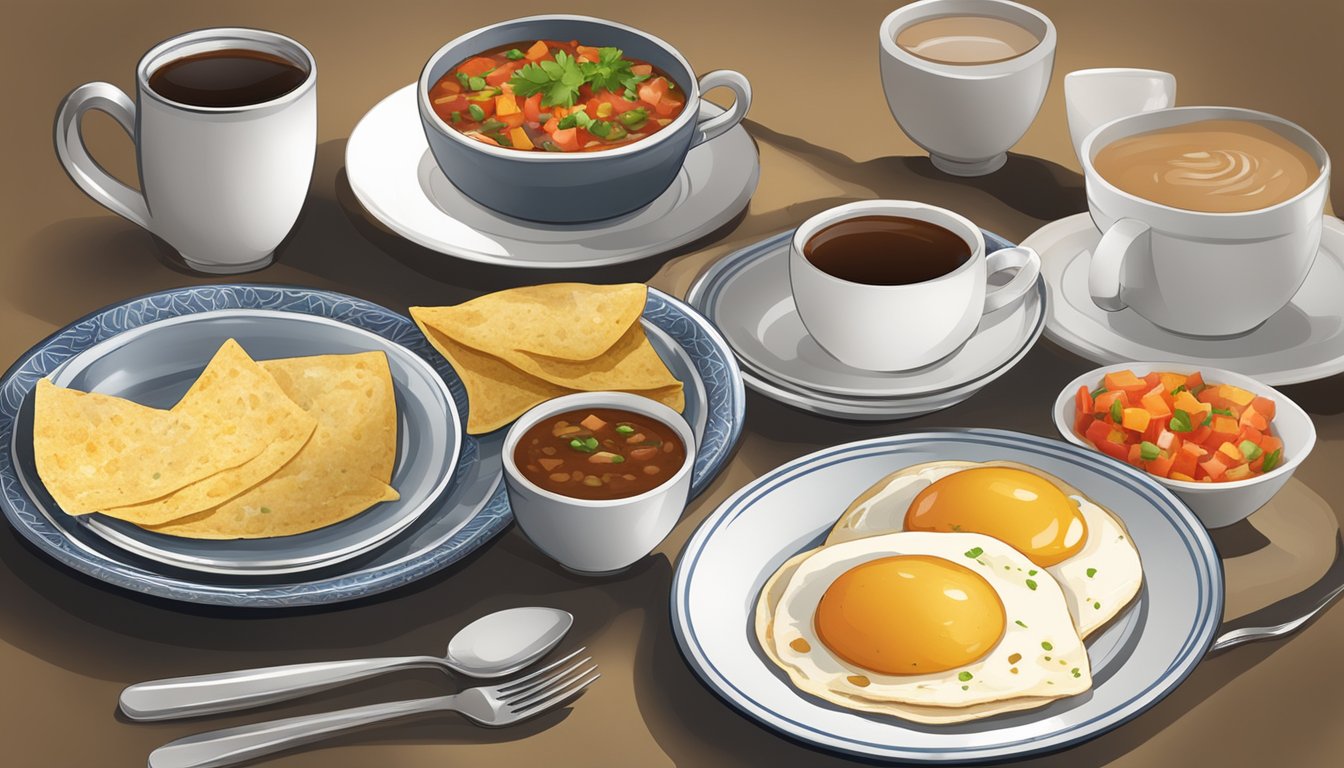Huevos Ahogados, or “drowned eggs,” is a Mexican breakfast dish that tantalizes taste buds with its rich flavors and hearty ingredients. This satisfying meal features eggs poached in a spicy tomato-based salsa, creating a perfect balance of textures and tastes. The best breakfast Huevos Ahogados combines fresh, high-quality eggs with a homemade salsa made from roasted tomatoes, chili peppers, and aromatic spices.
The preparation of Huevos Ahogados is simple yet rewarding. It begins with blending roasted tomatoes, jalapeños, onions, garlic, and cilantro to create a flavorful sauce. This mixture is then simmered in a pan until it thickens slightly. Eggs are carefully cracked into small wells made in the simmering sauce, where they poach to perfection.
Served with warm tortillas or crusty bread, Huevos Ahogados offers a versatile and customizable breakfast option. Diners can adjust the spice level to their liking and add toppings such as queso fresco or avocado for extra flavor and texture. This beloved dish showcases the vibrant culinary traditions of Mexico while providing a nutritious and satisfying start to the day.
Exploring Huevos Ahogados
Huevos Ahogados, a beloved Mexican breakfast dish, showcases the rich culinary traditions of Mexico. This flavorful meal combines eggs poached in a vibrant tomato-based salsa, creating a hearty and satisfying start to the day.
Origin and Cultural Significance
Huevos Ahogados, which translates to “drowned eggs,” originated in Mexico as a simple yet delicious breakfast option. The dish reflects the resourcefulness of Mexican cuisine, utilizing readily available ingredients to create a nourishing meal. It gained popularity in households and local eateries, becoming a staple of Mexican breakfast culture.
In many regions, Huevos Ahogados are enjoyed as a weekend brunch dish, bringing families together for a leisurely morning meal. The dish’s widespread appeal has led to its inclusion on menus in Mexican restaurants worldwide, introducing international diners to the bold flavors of authentic Mexican breakfast cuisine.
Traditional Ingredients
The key components of Huevos Ahogados are:
- Eggs
- Tomato-based salsa
- Garlic
- Onion
- Chile de Arbol (for heat)
- Cilantro (for garnish)
The salsa typically consists of ripe tomatoes, garlic, and onions blended to create a smooth sauce. Chile de Arbol or other spicy peppers are often added to give the dish its characteristic kick. Fresh cilantro is sprinkled on top for a burst of flavor and color.
Distinguishing Features
Huevos Ahogados stand out for their unique cooking method. The eggs are gently poached in the simmering salsa, absorbing its flavors as they cook. This technique results in tender eggs with slightly runny yolks, enveloped in a rich, spicy sauce.
The dish is typically served with warm corn tortillas, allowing diners to scoop up the eggs and salsa. Some variations include:
- Adding cheese for extra richness
- Incorporating beans for protein
- Serving with avocado slices for creaminess
The versatility of Huevos Ahogados allows for customization to suit different tastes and dietary preferences, making it a beloved choice for breakfast enthusiasts seeking a flavorful and satisfying meal.
Health and Nutrition
Huevos ahogados offers a nutritious start to the day, combining protein-rich eggs with fiber-filled beans and vegetables. This Mexican breakfast dish provides essential nutrients and healthy fats to fuel morning activities.
Protein and Fiber Content
Eggs form the protein base of huevos ahogados, delivering all nine essential amino acids. One serving typically contains 12-15 grams of high-quality protein, supporting muscle maintenance and satiety.
Beans add a fiber boost, with about 7-9 grams per serving. This combination of protein and fiber aids digestion and helps maintain steady blood sugar levels throughout the morning.
The dish often includes whole grain tortillas, further increasing the fiber content. These complex carbohydrates provide sustained energy and additional nutritional benefits.
Healthy Fats and Vegetables
Avocado, a common accompaniment, contributes heart-healthy monounsaturated fats. These fats support nutrient absorption and promote cardiovascular health.
Olive oil used in preparation adds beneficial polyunsaturated fats. It also contains antioxidants that may reduce inflammation.
Roma tomatoes in the salsa provide vitamins A and C, as well as lycopene, an antioxidant linked to various health benefits.
Jalapeños add capsaicin, which may boost metabolism and have anti-inflammatory properties.
The vegetable-rich salsa increases the overall nutrient density of the dish, offering a variety of vitamins, minerals, and phytonutrients.
Preparing the Base
The foundation of huevos ahogados lies in its flavorful base. A well-prepared salsa and broth are crucial for achieving the perfect balance of taste and texture in this Mexican breakfast dish.
Creating a Flavorful Salsa
Start with ripe tomatoes as the base of your salsa. Remove the cores and place them in a blender. Add garlic cloves, onions, and chili peppers for depth and heat. White onions work well, providing a sharp flavor.
For added complexity, consider roasting the tomatoes and peppers beforehand. This step enhances their natural sweetness and adds a smoky note. Hatch chiles are an excellent choice for a mild to medium heat level.
Blend the ingredients until smooth. Season with salt and pepper to taste. For extra richness, some recipes suggest adding a small amount of bouillon to the mixture.
Choosing the Right Broth
The broth forms the liquid component of the dish, allowing the eggs to poach gently. Chicken stock is a popular choice, offering a savory depth to the salsa mixture.
For a vegetarian option, use veggie stock instead. It provides a lighter flavor that lets the salsa shine. Ensure the broth is well-seasoned to complement the salsa.
Combine the blended salsa with your chosen broth in a large pan or skillet. Simmer the mixture for about 10 minutes to meld the flavors. This creates the perfect salsa broth for poaching the eggs.
Cooking the Eggs
Cooking eggs for huevos ahogados requires precise timing and technique to achieve the perfect texture. The eggs are poached directly in the flavorful salsa, infusing them with taste while maintaining their delicate structure.
Techniques for Poaching Eggs
Start by bringing the salsa to a gentle simmer over medium-low heat. Create small wells in the sauce using a spoon. Crack each egg into a separate small bowl before carefully sliding it into a well. This method prevents shell fragments and ensures proper placement.
Cover the pan and cook for 4-6 minutes for runny yolks, or 7-10 minutes for firmer yolks. The whites should be set while the yolks remain creamy. Avoid boiling the salsa, as this can lead to tough eggs.
For best results, use fresh eggs at room temperature. This helps them cook more evenly and hold their shape better in the sauce.
Incorporating Eggs into Salsa
The key to successful huevos ahogados lies in the harmony between eggs and salsa. As the eggs poach, they absorb the flavors of the surrounding sauce. The salsa should be thick enough to cradle the eggs but not so dense that it prevents even cooking.
Gently spoon hot salsa over the egg whites during cooking to help them set faster. This technique also ensures the tops of the eggs are evenly cooked. For added flavor, sprinkle fresh herbs or crumbled cheese over the eggs in the last minute of cooking.
Serve immediately in shallow bowls, spooning plenty of the flavorful salsa around each egg. Accompany with warm tortillas or crusty bread to soak up the delicious sauce.
Serving and Presentation
Huevos ahogados shine with thoughtful presentation and complementary accompaniments. The right garnishes and plating techniques elevate this Mexican breakfast dish from satisfying to spectacular.
Accompaniments and Garnishes
Warm tortillas are essential partners for huevos ahogados. Corn tortillas offer authentic flavor, while flour tortillas provide a soft, pliable option. Crusty bread serves as an alternative for sopping up the flavorful salsa.
Fresh cilantro adds a bright, herbaceous note when sprinkled over the eggs. Crumbled queso fresco or cotija cheese contributes a salty, tangy element that balances the rich salsa.
Sliced avocado offers creamy texture and healthy fats. A dollop of additional salsa on the side allows diners to adjust heat and flavor to their liking.
Plating Techniques
Serve huevos ahogados in a shallow bowl or plate with high sides to contain the salsa. Ladle the salsa first, then carefully place the poached eggs on top.
Arrange tortillas or bread on the side of the plate. Sprinkle cheese and cilantro over the eggs and salsa. Place avocado slices artfully around the edge of the dish.
For a family-style presentation, serve the eggs and salsa in a large, shallow casserole dish. Offer garnishes and accompaniments in separate bowls, allowing diners to customize their plates.
Alternative Variations
Huevos ahogados can be adapted in various ways to suit different tastes and dietary needs. Cooks can experiment with ingredients and cooking methods to create unique versions of this classic Mexican breakfast dish.
Similar Dishes
Huevos rancheros share similarities with huevos ahogados, featuring fried eggs served on tortillas with salsa. Shakshuka, a Middle Eastern dish, also resembles huevos ahogados with eggs poached in tomato sauce. Huevos abrazados, or “hugged eggs,” offer a twist by wrapping the eggs in tortillas before cooking in salsa.
These dishes all showcase eggs as the star ingredient, complemented by flavorful sauces and various accompaniments. Cooks can draw inspiration from these similar recipes to create their own unique versions of huevos ahogados.
Adapting the Recipe for Different Meals
Huevos ahogados can be easily modified for brunch or dinner. For a heartier meal, add diced potatoes or chorizo to the sauce before poaching the eggs. Experiment with different types of peppers to adjust the heat level.
Leftover huevos ahogados can be repurposed into tasty sandwiches or wraps. Simply reheat the eggs and sauce, then serve in a crusty roll or tortilla with avocado and cheese.
For a vegetarian version, replace the traditional chicken broth with vegetable broth. Vegans can substitute the eggs with tofu or chickpeas for a protein-rich alternative that still captures the essence of the dish.
Tips and Tricks
Master the art of huevos ahogados with these essential techniques. Elevate your dish by perfecting egg consistency, enhancing salsa flavors, and mastering storage methods.
Achieving the Perfect Egg Consistency
For ideal huevos ahogados, poach eggs to desired doneness. Crack eggs into small bowls before adding to simmering salsa. This ensures even cooking and prevents shell fragments. For runny yolks, cook 3-4 minutes. Firm yolks require 5-6 minutes.
Use a slotted spoon to remove eggs, allowing excess sauce to drain. Place on a paper towel briefly to absorb moisture. This step prevents soggy tortillas when serving.
Pro tip: Add a splash of vinegar to the salsa. It helps eggs maintain shape during poaching.
Enhancing the Salsa
Create a flavorful base for huevos ahogados with homemade salsa. Roast tomatoes, onions, and peppers for a smoky depth. Blend ingredients until smooth for traditional texture, or leave chunky for added bite.
Experiment with different chile varieties:
- Ancho: Mild, sweet flavor
- Guajillo: Medium heat, fruity notes
- Chipotle: Smoky, spicy kick
Adjust spice levels by adding or removing seeds. Fresh cilantro and a squeeze of lime juice brighten the salsa. For a richer sauce, incorporate chicken bone broth during simmering.
Reheating and Storage
Store leftover huevos ahogados in an airtight container in the refrigerator for up to 3 days. Separate eggs from salsa to prevent overcooking during reheating.
To reheat:
- Warm salsa in a pan over medium heat
- Add eggs and cover for 2-3 minutes
- Serve immediately
For best results, reheat eggs in 30-second microwave intervals to avoid rubbery texture. Freshen reheated dishes with chopped cilantro or a sprinkle of cheese.
Freeze salsa for future use in freezer-safe bags for up to 3 months. Thaw overnight in the refrigerator before reheating.
Side Dishes and Pairings
Complementary sides and beverages enhance the huevos ahogados experience. Traditional Mexican accompaniments and well-chosen drinks elevate this breakfast dish to new heights.
Traditional Mexican Sides
Refried beans are a classic pairing for huevos ahogados. These creamy, savory beans provide a rich contrast to the spicy eggs. Crispy quesadillas offer a delightful textural element. Filled with melted cheese and folded into a golden tortilla, they’re perfect for dipping into the flavorful sauce.
Warm corn or flour tortillas are essential for soaking up every last bit of salsa. Sliced avocado adds a cool, creamy texture that balances the heat of the dish. For extra protein and crunch, consider adding chorizo or crispy bacon bits as a topping.
A side of Mexican-style rice complements the eggs nicely. Its mild flavor and fluffy texture make it an ideal canvas for the vibrant salsa.
Beverage Recommendations
Mexican hot chocolate is an indulgent choice to accompany huevos ahogados. Its rich, chocolatey flavor with a hint of cinnamon pairs wonderfully with the savory breakfast.
For a refreshing option, try horchata. This sweet, rice-based drink helps cool the palate between bites of spicy eggs. Freshly squeezed orange juice offers a bright, citrusy contrast to the dish.
Coffee lovers will appreciate a strong cup of Mexican coffee. Its bold flavor stands up well to the robust taste of huevos ahogados. For a non-caffeinated option, consider agua fresca made with seasonal fruits.




